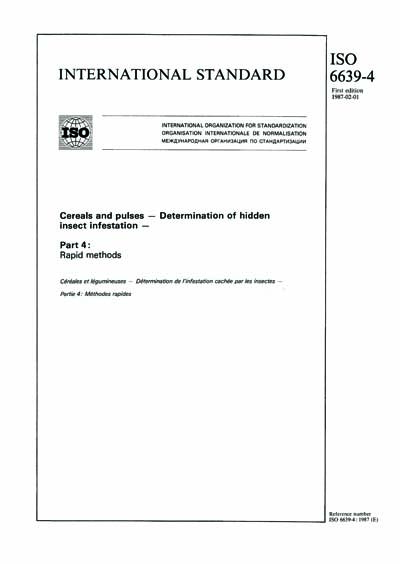Most recent
ISO 6639-4:1987
Cereals and pulses -- Determination of hidden insect infestation -- Part 4: Rapid methods
This part of ISO 6639 specifies five rapid methods for estimating the degree of, or detecting the presence of, hidden insect infestation in a sample. of a cereal or pulse.
The method is primarily intended for testing whole grains. It is not applicable for testing
- finely ground grain products, as there is a risk that particles of material will be sucked up with air samples; or
- grain products with moisture contents greater than 15 % (m/m), because of the risk of carbon dioxide produced by the products themselves and by micro-organisms interfering with the results.
In addition, the method is not applicable to the rapid testing of grain products on to which carbon dioxide has already been adsorbed in large quantities, for example grain stored in a confined atmosphere or when there are clear external indications of heavy infestation.
The method can be used for coarsely milled or kibbled grain products, provided that they have been sieved before testing to remove fine particles and loose insects.
The method does not permit the presence of dead adults, pupae, larvae or eggs to be detected.
The method is applicable to any dry grain prone to internal insect infestation, particularly wheat, sorghum, rice and similar sized grains. Large grains, such as maize, have to be partially broken (kibbled) before they can be tested. This treatment of large grains can cause some insects to be lost or fragmented, thus rendering the interpretation of results unreliable. Numbers of eggs and young larvae may be underestimated, but, in this respect, the method is no less efficient than any other.
The method is suitable for detecting hidden infestation in most cereals and pulses but only on a qualitative basis.
The method is suitable for detecting living insect adults and larvae feeding inside grains. It does not permit dead adults and larvae or living eggs and pupae (non-feeding stages) to be detected.
The method is suitable for detecting living and dead larvae and adults within grains. Insects which have been recently killed (for example by fumigation) may be difficult to distinguish from those still living.
International Organization for Standardization [iso]


